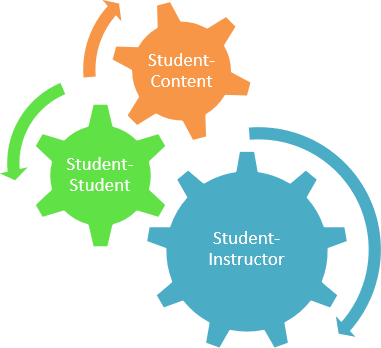
Student-content interaction is all about having students DO something meaningful related to the course content and then reflect on their learning. Reading and listening to lectures will be part of most classes, but passively receiving information isn’t enough to help students engage with the course and meet course learning outcomes.
Consider employing some of the following strategies to encourage effective student-content interaction. Students can:
- Write a summary (perhaps with a word limit!) or a Precis writing assignment
- Create an annotated visual on a PowerPoint or Google slide that shows their key take-aways from the reading.
- Fill out a Reading Graphic Organizer, where they summarize 3-5 key points and write one question they have based on the reading. Here’s more info.
- Identify what they find to be the muddiest point in the text. (Jamboard is a good interface for this.)
- Diagram a process, protocol, procedure or course of action. (Google slides is a good choice, or students can draw this by hand)
- Create a concept map or an infographic illustrating relationships.
- Create blog posts, collages, memes, or digital images related to lecture and course content (Padlet is a good interface for this.)
- Fill out a vocabulary crossword puzzle.
- Submit an end-of-module summary of key concepts.
- Students create short videos:
- Kines: doing a joint assessment on a friend
- Music Theory: playing chords progression on the piano, or sight singing
- Nursing: demonstrating assessment techniques on a friend.
Lecture: After a lecture, students complete a follow-up activity:
- Complete a Zoom poll to check comprehension or take an informal poll in Zoom Chat
- Answer questions on a worksheet based on new information in lecture. (James Wicks)
- Annotate on a Zoom whiteboard. Presentation with Megwen Loveless, Tulane University.
- Actively teach note-taking (Denise Necoechea.) Have students take a photo of their handwritten notes and post as an assignment in Canvas. (Can also upload typed notes.) Here is the graphic Denise Necoechea uses in her course to teach students note-taking skills. Here’s another one.
- Use EdPuzzle (Paul Schmelzenbach), or Canvas Quiz (Mike Dorrell) to embed a teaching video with questions.
- Have points in your video lecture where students are told to “pause the video” and write notes (Daphney Wadley)
Resources:
- Darby, F. (2019). Small Teaching Online: Applying Learning Science in Online Classes. Jossey-Bass
- Boettcher, J. V., Conrad, R. M (2016). The Online Teaching Survival Guide, 2nd ed. Jossey-Bass.
- Costa, K. (2020). 99 TIps for Creating Simple and Sustainable Educational Videos. Stylus.
- Riggs, S. (2020). Student-Centered Remote Teaching: Lessons Learned from Online Education. Transforming Higher Ed.